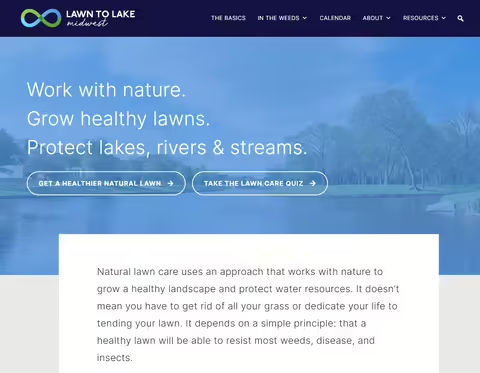URBANA, Ill. – Every summer weekend, like clockwork, the roar of lawnmowers fills neighborhoods across the state as homeowners and landscape companies try to keep up with the never-ending chore that is lawn care.
More and more lawn caretakers are becoming aware of how their patch of grass contributes to the wider ecosystem and are taking steps to keep their lawn healthy in a way that is low maintenance and keeps chemicals away from their family and out of local waterways.
Care for your lawn with confidence with help from the newly launched website, LawntoLakeMidwest.org — a free, comprehensive guide developed by water quality specialists and horticulture experts at Illinois-Indiana Sea Grant, University of Illinois Extension, and Purdue University.
Lawn to Lake provides homeowners, businesses, and landscape companies with best practices through tools such as a Natural Lawn Care Quiz and a month-by-month lawn care guide.
“This has always been an issue people care about,” says Allison Neubauer, Illinois-Indiana Sea Grant’s Great Lakes outreach associate. “With pesticides, so many people worry about their pets or their children spending time on their lawn. Or, they’re interested in using lawns in a way that will help pollinators or prevent flooding.”
Traditional lawn care relies on synthetic fertilizers and pesticides that run off into waterways when incorrectly or overapplied. But a 2019 statewide survey by Illinois-Indiana Sea Grant and University of Illinois found that lawn caretakers are concerned about keeping pesticides out of the environment, maintaining biodiversity, and improving local water quality.
Natural lawn care doesn’t mean getting rid of grass entirely or constant maintenance. Instead, it focuses on the simple fact that a healthy stand of turfgrass is naturally resistant to weeds, disease, and insects and as a result doesn’t need many, if any, chemicals added. A healthy lawn also acts like a sponge that absorbs and filters water, keeping pollutants out of stormwater systems.
“We came at this from a water quality standpoint to help people understand that their lawns are connected to larger bodies of water like Lake Michigan or the Mississippi River,” says Sarah Zack, University of Illinois Extension pollution prevention specialist. “The new website starts with the basic best practices, but you can also dig into details about a lot of topics like pest management or how to choose the right plants for your property.”
Natural lawn care involves mowing grass high to promote deep, healthy roots, and leaving clippings to return nutrients to the soil. Water efficiently and aim for a total of 1 inch a week including rainfall. Before adding fertilizer, test the soil to see what nutrients are needed.
For more information or questions about the website, contact Sarah Zack at iisg@purdue.edu or (765) 496-6009.
SOURCES: Allison Neubauer, Illinois-Indiana Sea Grant Great Lakes Outreach Associate; Sarah Zack, University of Illinois Extension pollution prevention specialist
WRITER: Emily Steele, Media Communications Coordinator, Illinois Extension
ABOUT ILLINOIS-INDIANA SEA GRANT: One of 34 Sea Grant Programs in the U.S., IISG is focused on the southern Lake Michigan region. The program is funded through National Oceanic and Atmospheric Administration (NOAA), the University of Illinois, and Purdue University, but IISG also works in partnerships with scientists, educators, policymakers, business leaders, and the public to work towards a healthy environment and economy.
ABOUT EXTENSION: Illinois Extension leads public outreach for University of Illinois by translating research into action plans that allow Illinois families, businesses, and community leaders to solve problems, make informed decisions, and adapt to changes and opportunities.
